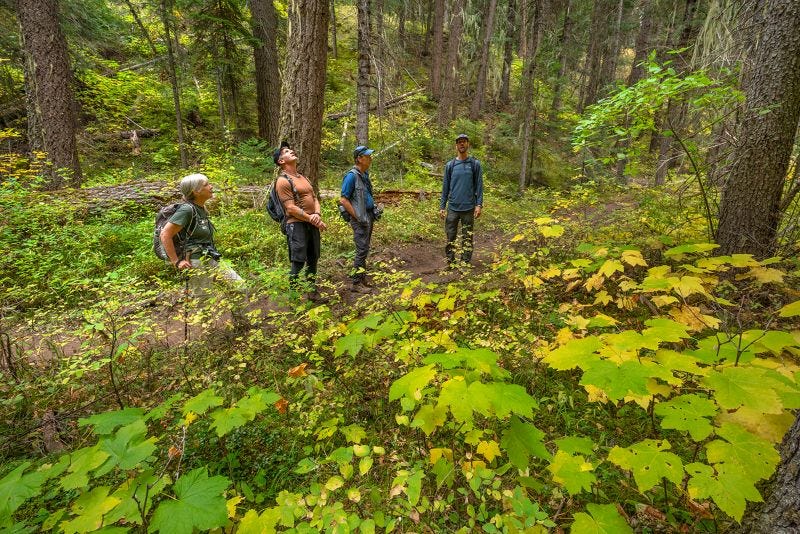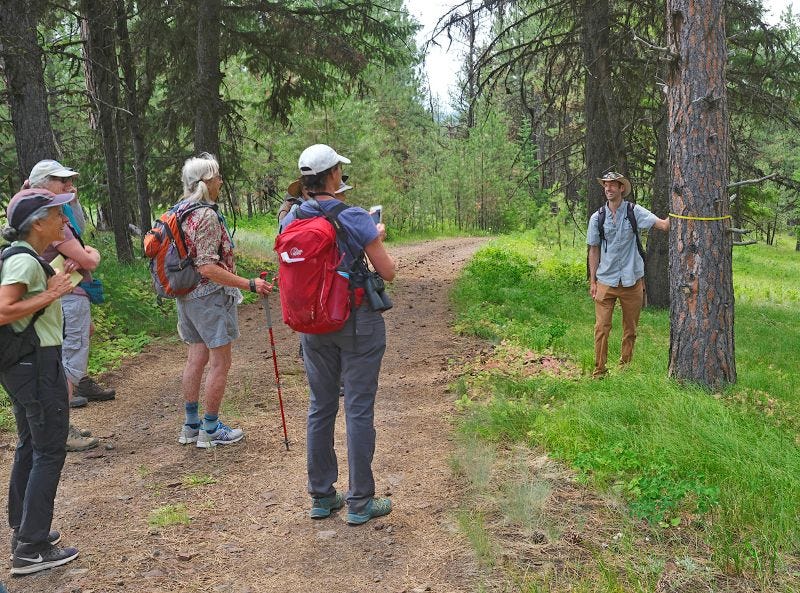
The surface temperature of a forest canopy typically runs 20 to 40 degrees Fahrenheit cooler than the surface of non-forested areas on hot afternoons.
I aimed the heat-sensing device at the street as Tony Davis and I crossed it. According to the device, the asphalt surface measured more than 120 degrees on this sunny November day in downtown Tucson.
As we passed trees or potted plants, I’d point the device’s infrared-sensing beam at the greenery. I wanted to show the longtime Arizona Daily Star environmental reporter how plants help moderate excess urban heat.
Invariably, the leaf surface temperatures would register in the 80s.
That is, until I aimed it at a vine hanging at street level from the second-story Playground Bar & Lounge in downtown Tucson: 120 degrees, the display claimed.
What? I looked closer. It was plastic.
I laughed. He didn’t end up using that incident in his story, but it stuck with me. I thought it was a great example of how plants, as long as they’re not plastic, moderate temperature.
The forests and the leaves
This experience comes to mind after a lively conversation yesterday with scientist David Mildrexler. In mid-March, I touched on some of his recent research relating to how the biggest trees store a disproportionate amount of forest carbon.
A terrestrial systems ecologist with Eastern Oregon Legacy Lands in Joseph, Oregon, Mildrexler is comfortable doing field measurements as well as crunching remote sensing data collected from satellites. Before coming back to that research based on field measurements, let’s look at some of his earlier work involving a satellite view of the planet’s surface temperature.
Like the heat sensing device I held, satellites also use thermal infrared energy to assess temperature. And Mildrexler found a similar situation when comparing the surface temperature of unforested areas to forest canopies around the world.
“The cooling role of forests has always been a remarkable power that forests have, compared to almost all other ecosystems on the planet,” he said during our Zoom conversation.
His research with others at the University of Montana compared air temperature—as measured at all the World Meteorological Organization weather stations around the planet—to satellite assessments of surface temperature near the sites.
As a reminder, weather stations always take air temperature measurements in the shade and about 5 feet above the ground to avoid capturing extra heating from the sun. Surface temperatures eventually heat the air, but not as quickly or thoroughly as the sun heats the surface—whether it's pavement, a forest canopy or our own skin.
The researchers focused on the hottest temperatures of the year, such as July and August in the northern hemisphere. During these hot afternoons, unforested sites near the stations typically hit peak surface temperatures about 20 to almost 40 degrees Fahrenheit higher than air temperatures.
Meanwhile, the surface temperatures of leafed-out forest canopies remained remarkably similar to air temperatures in sites ranging from the tropics to the poles.
That’s not to say forests will remain stable as climate change pushes temperatures beyond what these particular forest stands have experienced. In fact, dry conditions already can stress modern forests beyond their capacity to respond to rising heat.
David Mildrexler (far right) shows members of the public an Oregon site. Photo courtesy of David Mildrexler
Cooling local climate
How do forests keep the local climate cool?
Mildrexler talked about two main methods: transpiration, a form of evaporative cooling; and the less acknowledged way forest canopies help shift sensible heat up and away.
“Just like sweat cools our body, that cools the forest canopy,” he said, referring to the water released from leaves through transpiration. “We can’t see that with our eyes. But if we could see that transfer of water to the atmosphere, we would, I think, recognize just how much it is.”
Meanwhile, those of us who spent winters in the Windy City of Chicago or other northern cities have direct experience with the loss of sensible heat that occurs from the dreaded wind chill factor.
Of course, a summer breeze also cools things down, in a pleasant way. Some of this comes from the evaporative cooling, which I describe more here. But some of it results from the cooler air simply carrying heat away from our warmer bodies.
Throwing heat to the wind
The same concepts apply to forests.
“Trees also can shed heat with their complex canopy,” Mildrexler said. “The interaction that complex canopy has with the atmosphere helps shed heat through wind and turbulence. That’s another way they cool.”
In animals, a mouse cools off more quickly than an elephant because it has more surface area relative to its size. Similarly, your skinny, jacketed friend may be chilly in the same air that makes a heavier friend peel off a sweater.
In forests, the cooling depends mainly on the surface area of leaves. The bigger the tree, the more leaves it has. And the older the forest, in general, the more complex the canopy, with more layers of leaves over the same square footage of soil.
So big trees and old growth forests tend to shed more heat than small trees or young forests.
Size also helps when it comes to the evaporative cooling of transpiration. That’s because bigger trees have deeper roots that can reach water stored deep in the soil.
Mildrexler said the satellite study showed the most extensive cooling over lush forests with closed canopies, typically found in moist environments. In many of these, the evaporative cooling from transpiration rivaled that of wetlands with no lack of water to evaporate.
“The fact that we’re seeing that cooling role is evidence that these trees are accessing water and being able to transpire,” he said. “If trees weren’t able to reach that water and transpire it, they couldn’t cool themselves that way.”
David Mildrexler explains to a tour group how tree width (diameter) is measured. Photo courtesy of David Mildrexler
Cooling global climate
The biggest trees play the biggest role when it comes to moderating the temperature of our planet, too.
It’s an important role. The world’s forests still manage to absorb about a third of the carbon dioxide released annually by humanity’s burning of forests, coal, oil and gas.
As a reminder, carbon dioxide is the main heat-trapping gas spurring on our global warming. And trees convert airborne carbon into the carbon compounds comprising their trunks and branches.
Big trees store a disproportionate amount of carbon for their numbers. Globally, the largest 1 percent of trees in a typical forest stand hold about 50 percent of the carbon stored in above-ground vegetation.
Mildrexler’s research with colleagues using field measurements and precise equations to estimate total carbon storage found the biggest 3 percent of trees in
eastern Oregon’s mature and old-growth forests hold about 42 percent of the carbon stored in above-ground vegetation.
He attributes the smaller value, compared to global forests, to the extensive logging of big trees that has occurred in Oregon forests.
Unfortunately, the future could repeat the past if the Republican administration has its way. The U.S. House of Representatives passed a pro-timber bill now being considered by the Senate, and an executive order issued by Trump also aims to promote more logging in our national forests.
I’ll be writing more about those threats again soon. But for now, it’s worth reveling in just how much the world’s forests deal with the warming climate, both locally and globally.
“They’re cooling temperature, they’re pulling carbon out of the atmosphere, they’re storing it in their long-lived tissues,” Mildrexler said. “It’s an incredibly efficient, multi-faceted cooling role spread across the planet.”




